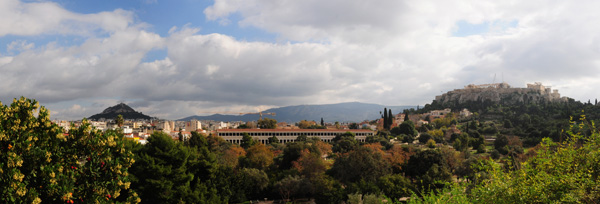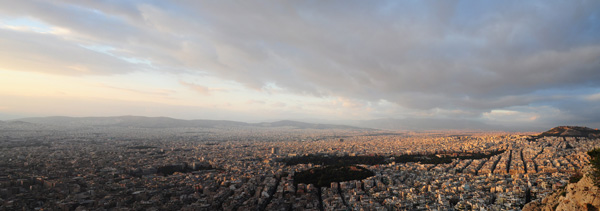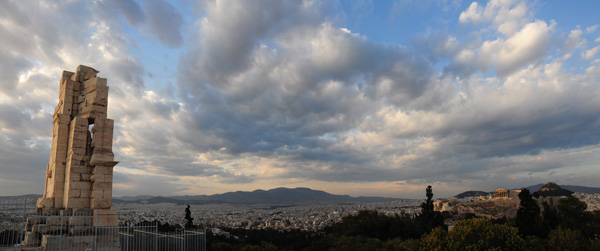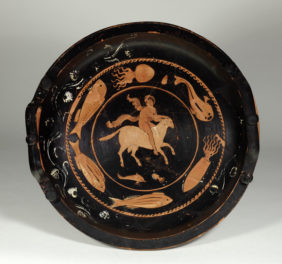
View of Athens towards the Piraeus from Mount Lykavittos, 2014. See this panorama larger.
While working at the Getty Villa as the graduate intern in the Department of Antiquities last year, I spent the majority of my time assisting with the development of the exhibition Greece’s Enchanting Landscape: Watercolors by Edward Dodwell and Simone Pomardi (on view through February 15). In choosing which drawings and watercolors to display from their vast output, writing labels and wall texts, and helping design the exhibition’s accompanying audio-visual components, I soon found myself immersed in the world of 19th-century Greece. Dodwell and Pomardi’s detailed drawings and paintings of the landscape of Greece juxtapose the ruins of antiquity with a contemporary Ottoman experience.
Of particular interest to me are Dodwell and Pomardi’s depictions of Athens—a city close to my heart since I lived there for nearly three years while in graduate school. Today’s Athens bears little resemblance to the far smaller town encountered by Dodwell and Pomardi, however. Greece’s modern capital is now a sprawling metropolis of concrete buildings, the tumultuous din of incessant motorcycles, and throngs of tourists passing through on the way to their holidays on the small, sunny islands of the Aegean.
It’s been more than a decade since I first stepped foot on Greek soil myself: As a sophomore in college, I participated in a summer study abroad program that focused on painting the Greek landscape through the medium of watercolor. That summer changed the course of my personal and professional aspirations, and I delved into studying the ancient Greek world intensively, eventually earning a PhD in Greek archaeology. I return to Greece nearly every year, but it was only after seeing an exhibition at the British Museum in 2013 of Dodwell and Pomardi’s watercolors that I began, almost subconsciously, to explore the potential of panoramic photography to elucidate the urban Athenian landscape.

The Athenian Agora as seen from the Temple of Hephaistos, 2014. See this panorama larger.
I shoot multiple photographs in succession without the aid of a tripod or any special lighting, and once home I take the images to the realm of the digital, stitching them together in Photoshop to form a sweeping panoramic view. In this regard, my approach mimics that of Dodwell and Pomardi to some extent. Although we know little of their exact processes, we do know that they used an optical device called a camera obscura in the field to determine their compositions with the utmost precision, and then took their preparatory drawings and sketches back to a studio, perhaps in Italy (where Dodwell settled after his travels), developing them into large-scale paintings. The exceptional detail of their images suggests a long process of careful, deliberate attention, both in their studies on site as well as their final paintings.

Athens, from top of Mousaion Hill, 1805, Edward Dodwell and Simone Pomardi. Four watercolors, each 23 5/8 × 42 1/8 in. The Packard Humanities Institute. See this panorama larger.

Winter Sunset over Athens from Mount Lykavittos, 2014. See this panorama larger.
This series of photographic panoramas was created during my year at the Getty, where, in traveling to Athens on two occasions, I brought along not only my camera but also a digital copy of Dodwell’s two-volume A Classical and Topographical Tour Through Greece, during the years 1801, 1805, and 1806 (Volume 1 and Volume 2), an encyclopedic tome of some 1,200 pages that records his astute observations as he traveled through Greece. Thanks to the wonders of digitization, I was able to read Dodwell’s monumental volumes on my iPad while exploring the Acropolis and a number of other locations in Athens.
My attempts to recreate in photographs the same viewpoints as Dodwell and Pomardi’s paintings resulted in a number of comedic errors, however; I found the modern landscape so changed from Dodwell and Pomardi’s perspective that on multiple occasions, I nearly fell off a cliff, or found myself surrounded by trees, buildings, and graffiti, without a clear view of their original compositions. Instead, I developed a sympathetic eye for the 19th-century artists in my fascination with their perspectives of Athens and Greece on a broad scale—an image that can be successfully accomplished through the wide format of a panorama, be it in a painting or a photograph. I then created my own series of views of Athens from some of its most advantageous viewpoints, stitching together multiple photographs to form expansive images of the modern city.

The Philopappos Monument and the Acropolis from Mouseion Hill, 2015. See this panorama larger.
Walking through the exhibition that’s currently on display at the Getty Villa, you are easily transported into the world of 19th-century Greece through the eyes of Edward Dodwell and Simone Pomardi. Through their carefully composed images and critical observations, they help us to understand not only the vastness of the Greek landscape, but the intricacy of its people, customs, and ruins as well. Their explorations of ancient and contemporary Greece in an era before photography provide an accurate rendering of a land they not only traversed, but commented upon with keen scrutiny, and I attempt to do the same in my explorations of the modern city.
Like Dodwell and Pomardi, these photographs are both documents of the present as well as resonant evocations of the past. Athens—and Greece—exists today in an atmosphere of constant change, beckoning further exploration from anyone who desires the challenge of capturing its complexity of sights, sounds, and experiences.
_______
See more of Jacquelyn’s photos on her website.




Comments on this post are now closed.